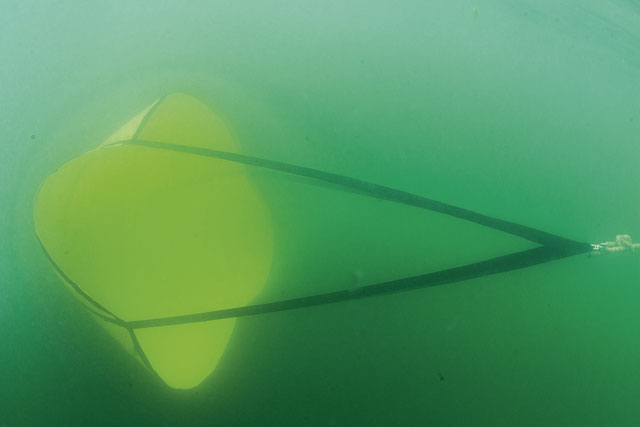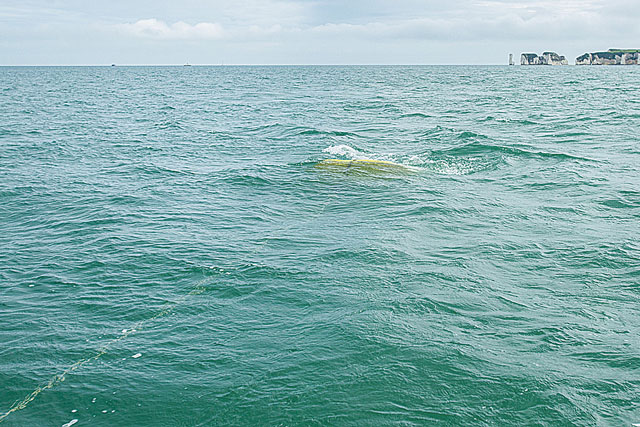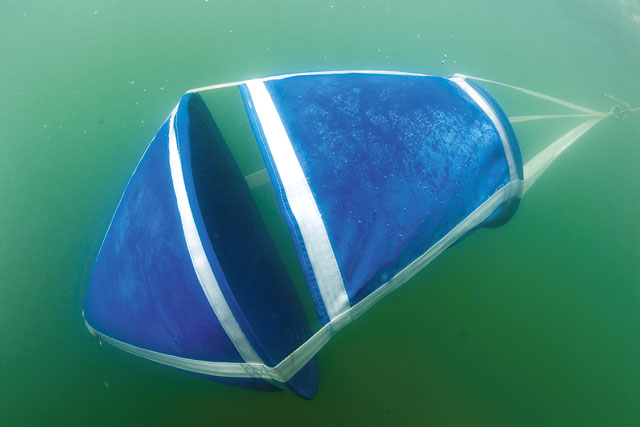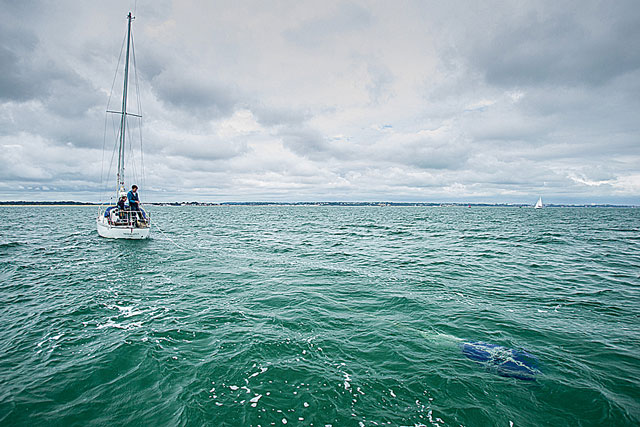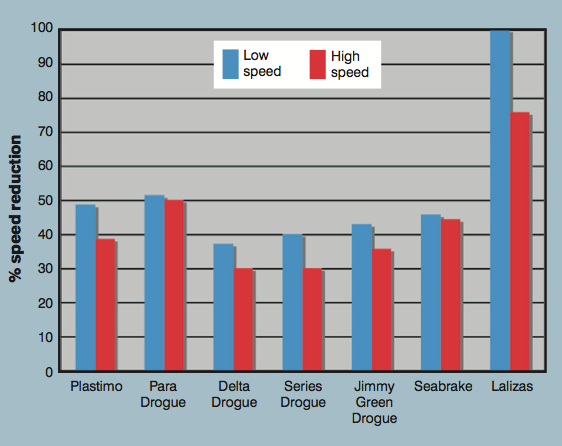When your boat’s being battered by a storm and you want to ride things out, a drogue will make things more comfortable. But which one should you buy? We tested 7 to find out...
Of all the safety kit we’re told is essential to ensure our safety at sea, a drogue is fairly low on most people’s lists, especially if they only sail in sight of land or in coastal hops. But drogues have many uses aboard, and could help you ride out a storm, enter a harbour safely, steer after the loss of a rudder or keep you safe under tow. They could, then, save your boat and your life. With many models available, we put seven to the test.
Drogue vs sea anchor?
Drogues and sea anchors are often lumped together as one and the same – in some cases by their manufacturers – but there is a difference in function. In appearance, they are similar, but they perform very different roles.
Sea anchors are designed to stop and ‘moor’ a boat bow-to the waves. They are used to ride out a storm, or to heave-to and take a rest. Drogues, or speed-limiting drogues as they are sometimes called, are used to keep a boat stern-to the waves. Unlike sea anchors they are not designed to stop the boat in the water, but instead to slow her down while keeping her from broaching beam-on to the waves. Sea anchors tend to be much bigger and must be deployed on a much longer and stretchier line.
There are also design factors at play. A sea anchor is relatively static in the water, whereas a drogue is designed to be towed at speed. That makes the design of a drogue important as it must produce less drag than a sea anchor, and yet be stable and resist any attempt to spin, slew or ‘porpoise’. An acknowledged authority on the subject is Victor Shane’s Drag Device Data Dase: using parachutes, sea anchors and drogues to cope with heavy weather. It lists the attributes that make a good drogue: ‘It must pursue a straight course, must track straight, must be faithful in retaining its shape. The standard for sizing is that a yacht should average 3-6 knots with a speed-limiting drogue in tow.’
Manufacturers address this in a number of ways, either by adding vents to the side or incorporating swivels to allow it to rotate safely.
7 of the best drogues available right now
Plastimo Sea Anchor (Drogue) review
- RRP: £59.95
- Diameter: 60cm • Length: 120cm
Plastimo’s offering is called a Sea Anchor, but its small size makes it much more suitable as a drogue. It’s made of vinyl in a cone shape, with a wire ‘hoop’ sewn into the open mouth to give it shape.
It deployed to its correct shape instantly at 3.5 knots, reducing the boat speed to 1.8 knots and putting a strain of 30kg on the line. At 7 knots, it reduced the boat speed to 4.3 knots, with the line strain increasing to 90kg.
It stayed well submerged, and didn’t break the surface. It tracked straight but had a tendency to rise and fall in the water. The addition of a length of chain helped to keep it lower in the water and improved this problem.
Recovery was relatively simple, although it took some time for the water to drain from the narrow exit. A tripline rigged from the point of the cone would make it easier to recover.
Note: We may earn a commission when you buy through links on our site, at no extra cost to you. This doesn’t affect our editorial independence.
Lalizas Professional Drogue review
- RRP: £65.99
- Diameter: 1.4m • Length: 1.65m
The Lalizas drogue is available in a number of sizes: we chose the smallest. However, with a 2m-wide mouth and measuring 1.65m long, it was enormous compared to the other drogues on test.
It gave us the highest readings of any we tested: When deployed at 3.5 knots it took 15 seconds to assume its shape, due to its size and the lack of wire to keep the mouth open.
But once it assumed the correct shape it stopped us completely, taking our 3.5 knots to nothing in seconds, which exerted 120kg on the line.
At higher revs, it took us from 7 knots to 1.7 knots, putting a strain of 150kg on the line. At these high loads it sat very near the surface, but didn’t porpoise or snake around.
This would be better suited as a sea anchor, the purpose of which is to stop the vessel, rather than a speed-limiting drogue, which should keep the vessel under controlled lower speed.
Recovery was hard work, but was made simpler if the drogue was capsized while pulling it onboard. A tripline, rigged to the loop at the narrow end of the cone, would make recovery much easier.
Oceanbrake Series Drogue review
- RRP: £468
- Diameter: 15cm • Length: 60m
This series drogue had 75 small cones on 60m of line, and a heavy loop of chain at the aft end. Oceanbrake say this is suitable for vessels of light displacement – 100 cones would normally be recommended. Nonetheless, it was very effective.
Deployment was simply a case of paying out the line, and it was much easier than the single drogues as the strain increased gradually, with none of the violent snatching experienced with the single-cone drogues.
Streamed astern in our engine tests, it reduced our speed from 3.5 knots to 2.1 knots, with the line experiencing 24kg strain. At higher revs, our speed was reduced from 7 knots to 4.9 knots at 104kg strain.
In the waves, we found the Series Drogue to be easy to deploy and to recover, and to be very controlled. There was no porpoising or snaking around, and the load increased in a gradual, controlled fashion. As a wave rolled under the boat, it kept a steady pressure on the line, keeping the stern to the waves, and the heavy chain and series of cones kept the pressure constant.
Recovery was easier than with single-element drogues: there was no need to collapse the multiple drogues and hauling in got easier as the line in the water got shorter. Its bulk and weight would be a lot to stow on a small boat, however.
Para-Tech Delta Drogue review
- RRP: $199 (£118)
- Diameter: 65cm • Length 47cm
Designed so that it cannot turn inside out, the Delta drogue is made from vinyl-coated nylon, and has a design akin to a tricorne hat. It is supplied with a meaty stainless swivel. Ours was a 36in model.
It reduced our speed from 3.5 knots to 2.2 knots at low revs, exerting 20kg on the line. At higher revs, it reduced our speed from 7 knots to 4.9 knots, exerting 80kg.
It broke the surface occasionally at higher speeds, but the addition of a short length of chain between the line and swivel kept it below the surface and made it much more controllable. We found it ideal as a steering aid. Recovery was simple thanks to the small size of the drogue.
Seabrake review
- RRP: £159
- Diameter: 62cm • Length 80cm
The Seabrake, made in Australia and sold in the UK by Emsworth-based Sea Teach (now Ocean Chandlery), comprises two parts – a cone and a body, with a vent between them.
It reduced the boat speed from 3.5 knots to 1.9 knots, with a strain of 32kg on the line. At higher speeds, it reduced the boat speed from 7 knots to 3.9 knots, exerting a 110kg force on the line.
Sea Teach supplied it with a 2m length of heavy galvanised chain, which kept it well below the surface and out of sight. Without the chain, the speeds and loads were unchanged, but it was visible, although it never broke the surface and was controlled and tracked straight. Recovery was simple, but a tripline would help collapse the cone to aid hauling on board.
Sea Teach also supplied a line and chain, ready-flaked into a mesh bag that was ready for deployment: a foam hoop kept the mouth open, which made both deployment and recovery easy with a crew member flaking the line into the bag.
Ocean Safety Para Drogue review – BEST ON TEST
- RRP: £395
- Diameter: 65cm • Length 60cm
The Para Drogue, made in Southampton by Ocean Safety, comprises two linked parts; an open-ended cone and an adjustable ‘mouth’. It deployed to its correct shape immediately, slowing the boat from 3.5 knots to 1.7 knots and experiencing a line load of 34kg.
At 7 knots, it reduced the boat’s speed to 3.5 knots with a line strain of 120kg. It stayed submerged, with no porpoising and very little yawing.
It’s well constructed, and its shape meant that it was easy to recover as the water drained out very quickly. It stows in a small, neat pouch. No tripline is required as recovery is simple.
Buy it now from oceansafety.com
Jimmy Green Yacht Drogue review – BEST BUDGET BUY
- RRP: £49
- Diameter: 54cm • Length 80cm
Jimmy Green, based in Beer in Devon, make a number of sizes of drogue – this one was a size 10, suitable for the 29ft Mohraina.
It comprises a PVC cone and at low revs reduced our speed from 3.5 knots to 2 knots, exerting 28kg on the line.
Flat out, it reduced the boat speed from 7 knots to 4.5 knots, exerting 100kg on the line.
It set immediately on immersion despite the lack of any stiffening to hold the mouth of the cone open, and behaved well underwater, with no spinning, slewing or porpoising.
A short length of chain helped keep it well submerged. It was simple to recover, and a tripline will help to collapse the drogue on recovery.
Buy it now from jimmygreen.co.uk
PBO Drogue test results
We were unable to test these drogues in extremis, but gathered some useful data from our test. It was reassuring that none of the drogues experienced problems at high speed: while some slewed around underwater, none of them broke the surface.
The Series Drogue was by far the easiest to handle, and would be extremely useful if heading off on a long trip in open water, where its ease of use and reputation in large waves would earn it a place in the lazarette despite its bulk relative to the others on test.
For the average coastal sailor, a single-element drogue is likely to be more use. Of these, the Para Drogue was well made, gave the most drag and came in a usefully-sized package. The Seabrake GP24 performed almost as well, for much less money. At the budget end, the Jimmy Green Marine Yacht Drogue 10 was a worthy performer at low cost.
Types of drogue and uses for a drogue
There are two main types of drogue – standard single-element cone-shaped drogues and their variations, and series drogues.
Single-element drogue
These come in many shapes and sizes, as we found out. Some solid plastic and metal drogues are available, but we were unable to obtain one in time for our trials.
Far more common are the fabric-types, which come in a range of sizes. Some are simply scaled-down sea anchors, but other drogues have a vent system or secondary body to keep them under control as they are dragged through the water.
Series drogue
Developed by the late Don Jordan, the series drogue comprises a long warp with upwards of 100 mini cones attached and a weight on the end. The warp is long enough to span two wave-lengths and the series of cones provides not only a backup and failsafe, but is also far less likely to pull out of the front of a wave, while the weight will keep the whole structure from snatching.
Using a drogue as emergency steering device
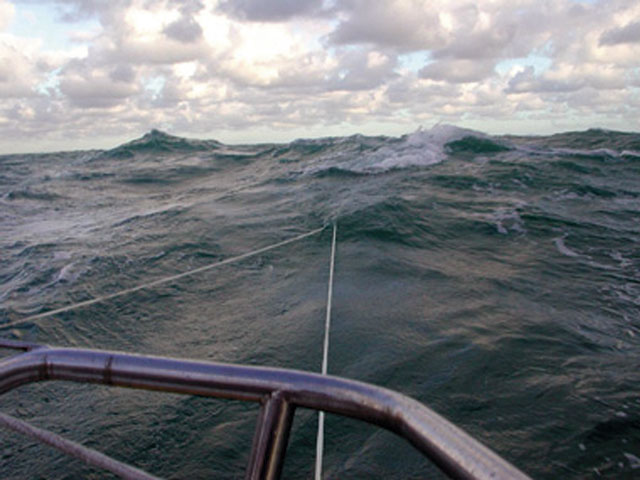
J-109 J-Fever arriving safely into Cherbourg without a rudder thanks to deploying and steering with a drogue
Many drogues are kept aboard as an emergency steering device. We looked at how to do this in an earlier feature. This photo shows how a J/109 made it into Cherbourg under sail after her rudder broke in 2010.
Using a drogue to stop surfing

Surfing down waves is exhilarating – for a few hours. On long passages, the ability to slow the boat down and keep her under control to allow the crew to rest is extremely useful.
A drogue to help navigate bars and narrow entrances

Used with care in narrow, shoaling harbour entrances, a drogue can assist in keeping you stern-to the waves and avoiding broaching.
A drogue to help control a boat under tow

A drogue streamed astern can help when a boat is being towed in waves, preventing snatching loads on the tow line and stopping the towed boat overtaking the boat doing the towing.
7 drogues tested: how we did it
We borrowed a Contest 29, Mohraina, moored at Poole’s East Dorset Sailing Club and owned by Dick Hanraads. We headed out of Poole Harbour with our seven drogues aboard. A test in extreme conditions was not possible, but a comparative test of each drogue’s holding and slowing power is a useful exercise. For our controlled tests, we deployed each drogue on a 40m length of line, and recorded the boat’s speed at two sets of engine revolutions that had given us 3.5 knots and 7 knots of boat speed respectively. This meant that, initially, the boat was travelling at around 3.5 knots as the drogue was deployed, to simulate the likely speed that you’d deploy the drogue in reality. We looked at the time it took to reach its correct shape and deploy. We also measured the drag force of each drogue using a 100kg spring balance in one side of a 2:1 purchase. The figure, doubled, would then give us the strain on the line.
From a RIB, we monitored the behaviour of the drogue, checking that it pursued a straight course and that it remained below the surface – no problem in our flat water conditions, but a big problem in waves. We then examined how easy it was to retrieve each drogue.
Finally we headed round Old Harry Rocks to sit in the overfalls off Handfast Point. There was a brisk south-westerly, blowing around 15 knots, which gave use some wave conditions to play with, and we tried steering with the drogues as well as handling them in rougher water and seeing how the boat responded.
Streaming warps vs drogue – which is best?
Read classic Hiscock, Chichester, Knox-Johnston or the Smeetons and you’ll not have long to wait before reaching tales of warp streaming. Streaming warps we tried to use the same test methods as for the drogues, but registered low readings of 4kg strain with 0.1 knot difference for a 40m warp streamed astern, and 8kg and 0.3 knots respectively for the same warp streamed in a bight. If you don’t have a drogue this is worth trying, and might keep your stern to the waves enough to make things more comfortable, but it will have nowhere near the same level of drag as a dedicated drogue.







